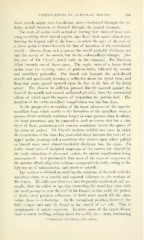Page 503 - My FlipBook
P. 503
COMPLICATIONS OF ALVEOLAR ABSCESS. 501
these vessels might travel to distant parts—backward through the in-
ferior dental foramen, or forward through the mental foramen.
The roots of molar teeth instead of having their thinnest bony cov-
ering overlying their buccal aspects, may have their apices almost per-
forating the lingual wall of the bone ; in others the apex of the root of
a lower molar is found beneath the line of insertion of the mylo-hyoid
muscle. Abscess from such a case as this would probably discharge not
into the cavity of the mouth, but in the submaxillary triangle. (See
the case of Dr. Cryer's noted early in the chapter.) Dr. Harrison
Allen ' records one of these cases. The septic roots of a lower third
molar were the exciting cause of pericementitis, followed by osteitis
and maxillary periostitis. Pus found exit beneath the mylo-hyoid
muscle and gravitated, forming a collection about the hyoid bone, and
from that point passed upward upon the face in the line of the facial
artery. The abscess in addition pressed directly upward against the
floor of the mouth and caused unilateral glossitis, from the mechanical
effects of which upon the organs of respiration the patient died. The
duration of the extra-maxillary complication was but four days.
In the progressive resorption of the inner substance of the superior
maxillary bone which results in the formation of the maxillary sinus, a
process which certainly continues longer in some persons than in others,
the bony structures may be removed to such an extent that but a thin
layer of bone, periosteum and mucous membrane covers the apices of
the roots of molars. Dr. Cryer's sections exhibit two cases in which
the excavation of the sinus has proceeded down between the roots of an
upper molar, creating such a condition that abscess upon either palatal
or buccal roots must almost inevitably discharge into the sinus. No
doubt many cases of incipient empyema of the antrum are aborted by
the early extraction of abscessed molars, the antral complication being
unrecognized. It is presumable that most of the cases of empyema of
the antrum afford sul)jective evidence comparatively early, owing to the
lighting up of inflammation and purulent catarrh.
The student is advised, in studying the relations of the teeth with the
maxillarv sinus, to a careful and repeated reference to the sections of
Dr. Cryer. He calls attention to a fact frequently overlooked and un-
taught, that the orifice or opening connecting the maxillary sinus with
the nasal passage is near the roof of the former, so that while the patient
is in the erect position collections of fluid must nearly fill the sinus
before there is a discharge. In the recumbent position, however, the
fluid escapes and may be found in the nostril of one side. This is
symptomatic of antral empyema. In acute cases of the antral disease
there is much swelling, wdema about the eyelid, etc, ; sharp lancinating
' (iarretson's Oral Surgery, 6th edition.


